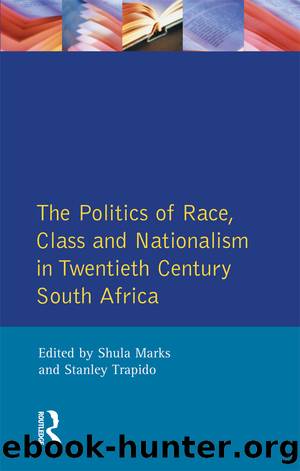The Politics of Race, Class and Nationalism in Twentieth Century South Africa by S. Mark Stanley Trapido S. Marks

Author:S. Mark, Stanley Trapido, S. Marks [S. Mark, Stanley Trapido, S. Marks]
Language: eng
Format: epub
ISBN: 9781317868965
Barnesnoble:
Publisher: Taylor & Francis
Published: 2014-09-25T00:00:00+00:00
The Garveyism of James S. Thaele and the ANC
On December 4, 1922, G. Boyes, a Cape Town magistrate, wrote to E. Barrett, Secretary of Native Affairs: âThe evolution, amalgamation of native black races and the various changes and movements are, in my opinion, rapidly arriving at a crisis.â53 Thus, by early 1922, the Lovedale establishment was articulating the concern it felt in light of the impression that Garveyâs ideas had been making on members of the African educated élite: âMarcus Garvey carries away some of our Native friendsâ, an editorial in the South African Outlook lamented. The Garvey movement, the editorial went on, âseduced not a few earnest workers for the wellbeing of Bantu South Africa away from paths of practical service, into dubious and sterile relationshipsâ, causing âtheir attitude towards the Europeans with whom before they were co-operating [to become] embittered.â54 At about the same time as this editorial was published, the Native Affairs Department reported an almost identical concern but on a much broader scale: âThe race consciousness of the South African Native is steadily growingâ, it declared, warning that âThe danger lies in the probable tendencies of the development of race consciousness to become anti-European and to seek expression in action subversive of law and order.â55
In face of this mounting pressure from an aroused African racial consciousness consequent upon the âAfrica for the Africansâ movement, âProfessorâ James S. Thaele, BA, BSc., former Lovedale student, arrived back in South Africa after being away in the United States for ten years, during which time he graduated from Lincoln University and the University of Pennsylvania. But Thaele was also, in an important sense, a graduate of the Ethiopian movement, since he had been among the twenty-two South African students who attended Lincoln University, one of the major Afro-Americn centres of higher education in the United States, between 1896 and 1924. Moreover, Thaeleâs subsequent plan for an âAfrican land settlementâ scheme (Thaele was general secretary and S. M. Bennet Ncwana was president), whose aim was âinducing Natives living in towns to settle on the landâ, would appear to have connected him to that phase of the earlier Ethiopian phenomenon which involved land purchases. Thaeleâs plan, in fact, bore a certain resemblance to the AMEâs land syndicate scheme organised by the AMEâs Rev. Allen Henry Attaway, principal of Bethel Institute, which consisted of a 10,000-acre farm at Croen River, the later site of the AMEâs Chatsworth Industrial High School.
Described by commentators as flamboyant and eccentric in terms of both rhetoric and dress â âspasms of twisted eloquence and weird posturingsâ was Umteteli wa Bantuâs contemporary description â Thaele, in fact, personified the âAmerican Negroâ style of post-war Cape Town radicals. Thaele, upon his return from the United States, quickly moved the Western Cape Congress of the ANC into a radical Garveyite direction, in the process becoming simultaneously the driving force of Cape Town Garveyism. The same overlapping quality was to be repeated when the ICU moved its headquarters from Cape Town to
Download
This site does not store any files on its server. We only index and link to content provided by other sites. Please contact the content providers to delete copyright contents if any and email us, we'll remove relevant links or contents immediately.
Verus Israel: Study of the Relations Between Christians and Jews in the Roman Empire, AD 135-425 by Marcel Simon(569)
Phoenicians among Others: Why Migrants Mattered in the Ancient Mediterranean by Denise Demetriou(568)
Caesar Rules: The Emperor in the Changing Roman World (c. 50 BC â AD 565) by Olivier Hekster(551)
Europe, Strategy and Armed Forces by Sven Biscop Jo Coelmont(494)
Give Me Liberty, Seventh Edition by Foner Eric & DuVal Kathleen & McGirr Lisa(464)
Banned in the U.S.A. : A Reference Guide to Book Censorship in Schools and Public Libraries by Herbert N. Foerstel(462)
american english file 1 student book 3rd edition by Unknown(455)
Reading Colonial Japan by Mason Michele;Lee Helen;(453)
The Roman World 44 BC-AD 180 by Martin Goodman(452)
DS001-THE MAN OF BRONZE by J.R.A(437)
The Dangerous Life and Ideas of Diogenes the Cynic by Jean-Manuel Roubineau(429)
The Oxford History of World War II by Richard Overy(427)
Imperial Rome AD 193 - 284 by Ando Clifford(426)
Introducing Christian Ethics by Samuel Wells and Ben Quash with Rebekah Eklund(426)
Basic japanese A grammar and workbook by Unknown(426)
Literary Mathematics by Michael Gavin;(385)
Language Hacking Mandarin by Benny Lewis & Dr. Licheng Gu(366)
How to Reach the 9.0 in IELTS Academic Reading by IELTS Medical(350)
The Oxford History of the Renaissance by Campbell Gordon;(342)
